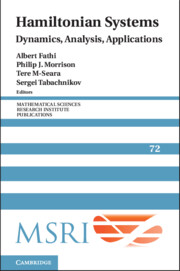Book contents
- Frontmatter
- Contents
- Denjoy subsystems and horseshoes
- Impact Hamiltonian systems and polygonal billiards
- Some remarks on the classical KAM theorem, following Pöschel
- Some recent developments in Arnold diffusion
- Viscosity solutions of the Hamilton–Jacobi equation on a noncompact manifold
- Holonomy and vortex structures in quantum hydrodynamics
- Surfaces of locally minimal flux
- A symplectic approach to Arnold diffusion problems
- Hamiltonian ODE, homogenization, and symplectic topology
- References
Holonomy and vortex structures in quantum hydrodynamics
Published online by Cambridge University Press: 10 May 2024
- Frontmatter
- Contents
- Denjoy subsystems and horseshoes
- Impact Hamiltonian systems and polygonal billiards
- Some remarks on the classical KAM theorem, following Pöschel
- Some recent developments in Arnold diffusion
- Viscosity solutions of the Hamilton–Jacobi equation on a noncompact manifold
- Holonomy and vortex structures in quantum hydrodynamics
- Surfaces of locally minimal flux
- A symplectic approach to Arnold diffusion problems
- Hamiltonian ODE, homogenization, and symplectic topology
- References
Summary
We consider a new geometric approach to Madelung’s quantum hydrodynamics (QHD) based on the theory of gauge connections. Our treatment comprises a constant curvature thereby endowing QHD with intrinsic nonzero holonomy. In the hydrodynamic context, this leads to a fluid velocity which no longer is constrained to be irrotational and allows instead for vortex filaments solutions. After exploiting the Rasetti–Regge method to couple the Schrödinger equation to vortex filament dynamics, the latter is then considered as a source of geometric phase in the context of Born–Oppenheimer molecular dynamics. Similarly, we consider the Pauli equation for the motion of spin particles in electromagnetic fields and we exploit its underlying hydrodynamic picture to include vortex dynamics.
Keywords
- Type
- Chapter
- Information
- Hamiltonian SystemsDynamics, Analysis, Applications, pp. 173 - 214Publisher: Cambridge University PressPrint publication year: 2024

